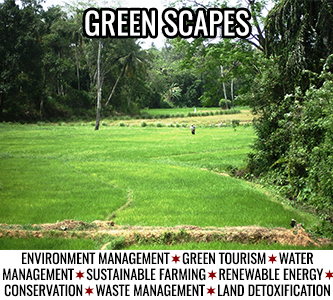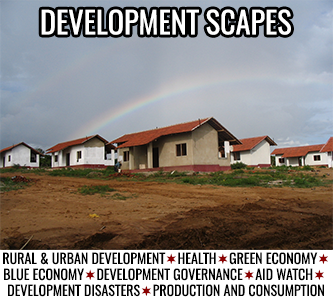





Ok! So we can break our work down according to the scheme above. Congratulations us! But? Yuck! That is possibly the most horrible way of describing the areas we work in. So we simplified. As you can see in the four neat pictorial boxes. It certainly tastes better and is more palatable but? It is still stupidly yuck!
Sectoring is a very difficult subject for us. We don’t consume it well nor can we digest it properly. The reason is that we don’t think that way and neither does nature. You see, the natural world does not behave in a sectoral way. It works as a whole. Therefore, a group of people who work with nature know full well that creating sectors is unnatural and working with nature through such compartments is fraught with all sorts of traps. This is why we can telescope the 17 SDGs into 8 as seen on the left hand side of the headline banner and eventually, reduce it to just 1 or, in our lexicon – an amorphous whole that is simple, easy, and natural.
But then again, we know that these “areas of engagement” as it were, are a creation of the age of specialization or, the age of industry. Starting with education, this mechanism of silo-treating knowledge and the idea that everything can be studied or engaged by breaking it apart has spidered down into all areas of human effort and upshoots just three things – confusion, disconnect and falsehoods. The crises we face are the result of that nuttiness. Yet, over the last few centuries, our DNA seems to be wired to this sort of approach. Most do not seem to get anything at all unless it is stratified, compartmentalized, linearized and micronized. So, we will accede to that thinking because…well, there is no good reason except perhaps we are a gentle folk and shrug it all off as an aberration of the comparatively ignorant. Or, as some residual remnant of the bad old days (are we talking down to you? Yes! Are you getting angry? Good! You will need that anger if you are going to dig your heads out of the rear of the Industrial Age and start consuming the realities of the Sustainable Age).
 Let us explain. Despite the fact that knowledge or knowing (as opposed to learning), by its very definition should be an all-encompassing whole, we concluded that we could become “knowledgeable” by acquiring fact-nuggets selectively. This is the result of a fact of science, which proposes, aggressively promotes, and, teaches us that everything can be broken down into their component pieces, studied in a mutually disassociated state, deductively or inferentially linked together through analysis and understood as a whole. The rationale stems, as Thom Hartmann says, from thinking such as this: If you break a car into its component parts, you can understand exactly how it works and if you put it back together, it will come back up alive. However, and here is the fallacy of that argument, if you do that to a dog, regardless of how competent a surgeon you are, once one puts it back together it will remain dead. Something very essential to the idea of the living dog, the whole of its existence is lost in the process of dismembering it. As a matter of fact, when attempting to understand systems that exist dependent on the right juxtaposition of a very large number or even an infinite number of parameters (such as a living being, an ecosystem, a social group, a nation etc.), breaking things down has only one practical outcome – it breaks them.
Let us explain. Despite the fact that knowledge or knowing (as opposed to learning), by its very definition should be an all-encompassing whole, we concluded that we could become “knowledgeable” by acquiring fact-nuggets selectively. This is the result of a fact of science, which proposes, aggressively promotes, and, teaches us that everything can be broken down into their component pieces, studied in a mutually disassociated state, deductively or inferentially linked together through analysis and understood as a whole. The rationale stems, as Thom Hartmann says, from thinking such as this: If you break a car into its component parts, you can understand exactly how it works and if you put it back together, it will come back up alive. However, and here is the fallacy of that argument, if you do that to a dog, regardless of how competent a surgeon you are, once one puts it back together it will remain dead. Something very essential to the idea of the living dog, the whole of its existence is lost in the process of dismembering it. As a matter of fact, when attempting to understand systems that exist dependent on the right juxtaposition of a very large number or even an infinite number of parameters (such as a living being, an ecosystem, a social group, a nation etc.), breaking things down has only one practical outcome – it breaks them.
So, we prefer to go down to the holistic root as seen in the diagram at left and not to the specialized leaves.! But, for everyone’s peace of mind, we have given you our sectors.
Thank you for contacting us and alerting us to your problem.
There can be many issues that assail our citizens. They could be environmental, social, cultural, developmental among other things. Be they policy issues or issues related to practical problems on the ground, we might be able to help you. Let us know the problem and, once we check on the matter and validate its existence, we will contact you within two working days.




